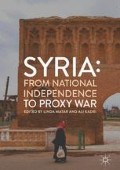Abstract
The chapter provides a comprehensive analysis of Syria’s economic and social trends. Weak development was in place since the 1980s, and the introduction of gradual laissez-faire economic policies exacerbated the socioeconomic conditions, tarnishing the social contract that was in place. The Syrian people were aware that violent confrontation would impart heavy costs. No sooner than the peaceful demonstrations began, the external forces intervened to turn what was a peaceful protest into a militarised conflict.
Access this chapter
Tax calculation will be finalised at checkout
Purchases are for personal use only
Notes
- 1.
The SCPR adjusted the deflator for the manufacturing sector; consequently the overall GDP growth rate for the period between 2001 and 2010 changed accordingly; see SCPR (2016a).
- 2.
See SCPR (2016b), Forced Dispersion.
- 3.
Ibid.
- 4.
Ibid.
- 5.
Estimated expenditure in the general budget 2010, Central Bureau of Statistics 2011, Table 14/3.
- 6.
Author’s calculations based on data from Syria Statistical Abstracts, various years.
- 7.
Part of the “semi-public” expenditure is allocated to militaryexpenditure and the other part to services; see SCPR (2016a).
- 8.
The estimation is based on the newly calculated life tables that estimated life expectancy at birth in 2010 at 70.5 years (SCPR 2016a).
Bibliography
Central Bureau of Statistics. (2011). Syrian Statistical Abstract. Damascus: Central Bureau of Statistics.
Central Bureau of Statistics. (n.d.). Syrian Statistical Abstract. Damascus: Central Bureau of Statistics, various years.
El Laithy, H., & Abu-Ismail, K. (2010). Poverty and the Equitable Distribution in Syria. Damascus: UNDP.
UNDP. (2016). Human Development Report. New York: UNDP.
Syrian Center for Policy Research (SCPR). (2013). Socioeconomic Roots and Impacts of the Syrian Crisis. Damascus: Syrian Centre for Policy Research.
Syrian Center for Policy Research (SCPR). (2016a). Confronting Fragmentation: Impact of the Syrian Crisis Report. Damascus: Syrian Centre for Policy Research.
Syrian Center for Policy Research (SCPR). (2016b). Forced Dispersion: A Demographic Report on the Human Status in Syria. Damascus: Syrian Centre for Policy Research.
Author information
Authors and Affiliations
Editor information
Editors and Affiliations
Rights and permissions
Copyright information
© 2019 The Author(s)
About this chapter
Cite this chapter
Marzouk, N. (2019). The Syrian Conflict: Selective Socioeconomic Indicators. In: Matar, L., Kadri, A. (eds) Syria: From National Independence to Proxy War. Palgrave Macmillan, Cham. https://doi.org/10.1007/978-3-319-98458-2_6
Download citation
DOI: https://doi.org/10.1007/978-3-319-98458-2_6
Published:
Publisher Name: Palgrave Macmillan, Cham
Print ISBN: 978-3-319-98457-5
Online ISBN: 978-3-319-98458-2
eBook Packages: Political Science and International StudiesPolitical Science and International Studies (R0)

